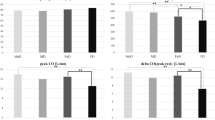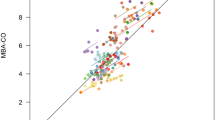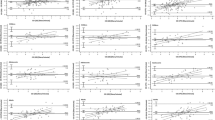Abstract
Given the increasing use of noninvasive techniques for the assessment of cardiac function in clinical practice, the aim of this study was to evaluate if stroke volume (SV) and cardiac output (CO) measurements obtained by PhysioFlow impedance cardiography or HDI CR-2000 pulse wave analysis (Pulse) are interchangeable with measurements obtained by echocardiography in patients with coronary artery disease (CAD) or heart failure (HF). The study involved 48 men with heart disease (CAD or HF). We compared SV and CO measurements with the three devices at rest, as well as relative changes in SV and CO derived from a rehabilitation program. SV and CO measurements were carried out first by echocardiography and immediately after using tonometry and impedancemetry techniques simultaneously. The Bland–Altman analysis showed a significant bias in the measurement of absolute SV and CO values with Pulse and PhysioFlow. Four quadrant plot and polar plot analysis of relative change SV between Pulse and echocardiography show a rate of concordance of 77% (95% CI 60–88%) and 79% (95% CI 63–89%) respectively. The polar plot analysis showed a mean polar angle of 34° ± 22°, and a 30° radial sector containing 52% of the data points. Both Pulse and PhysioFlow devices overestimate absolute SV and CO values compared to values recorded using echocardiography. Similarly, neither Pulse nor PhysioFlow reliably track SV or CO changes after a rehabilitation program compared with echocardiography.



Similar content being viewed by others
References
Tonelli AR, Alnuaimat H, Li N et al (2011) Value of impedance cardiography in patients studied for pulmonary hypertension. Lung 189:369–375. https://doi.org/10.1007/s00408-011-9299-y
Tan KH, Lai FO, Hwang NC (2006) Measurement of cardiac output using Physio Flow with different positions of electrode placement. Singap Med J 47:967–970
Reeves JT, Grover RF, Blount SG, Filley GF (1961) Cardiac output response to standing and treadmill walking. J Appl Physiol 16:283–288. https://doi.org/10.1152/jappl.1961.16.2.283
De Maria AN, Raisinghani A (2000) Comparative overview of cardiac output measurement methods: has impedance cardiography come of age? Congestive Heart Fail 6:60–73
Min M, Annus P, Kõiv H, et al (2017) Bioimpedance sensing - a viable alternative for tonometry in non-invasive assessment of central aortic pressure. In: 2017 IEEE International Symposium on Medical Measurements and Applications (MeMeA). pp 373–378
Richard R, Lonsdorfer-Wolf E, Charloux A et al (2001) Non-invasive cardiac output evaluation during a maximal progressive exercise test, using a new impedance cardiograph device. Eur J Appl Physiol 85:202–207. https://doi.org/10.1007/s004210100458
Zayat R, Goetzenich A, Lee J-Y et al (2017) Comparison between radial artery tonometry pulse analyzer and pulsed-Doppler echocardiography derived hemodynamic parameters in cardiac surgery patients: a pilot study. PeerJ 5:e4132. https://doi.org/10.7717/peerj.4132
Scolletta S, Franchi F, Romagnoli S et al (2016) comparison between doppler-echocardiography and uncalibrated pulse contour method for cardiac output measurement: a multicenter observational study. Crit Care Med 44:1370–1379. https://doi.org/10.1097/CCM.0000000000001663
Romagnoli S, Ricci Z, Romano SM et al (2013) FloTrac/Vigileo(TM) (third generation) and MostCare(®)/PRAM versus echocardiography for cardiac output estimation in vascular surgery. J Cardiothorac Vasc Anesth 27:1114–1121. https://doi.org/10.1053/j.jvca.2013.04.017
Kemps HM, Thijssen EJ, Schep G et al (2008) Evaluation of two methods for continuous cardiac output assessment during exercise in chronic heart failure patients. J Appl Physiol 105:1822–1829. https://doi.org/10.1152/japplphysiol.90430.2008
Charloux A, Lonsdorfer-Wolf E, Richard R et al (2000) A new impedance cardiograph device for the non-invasive evaluation of cardiac output at rest and during exercise: comparison with the “direct” Fick method. Eur J Appl Physiol 82:313–320
Boussuges A (2006) Immersion in thermoneutral water: effects on arterial compliance. Aviat Space Environ Med 77:1183–1187
Zimlichman R, Shargorodsky M, Boaz M et al (2005) Determination of arterial compliance using blood pressure waveform analysis with the CR-2000 systemReliability, repeatability, and establishment of normal values for healthy European population—the seven European sites study (SESS). Am J Hypertens 18:65–71. https://doi.org/10.1016/j.amjhyper.2004.08.013
McVeigh GE, Bratteli CW, Morgan DJ et al (1999) Age-related abnormalities in arterial compliance identified by pressure pulse contour analysis aging and arterial compliance. Hypertension 33:1392–1398
Belardinelli R, Ciampani N, Costantini C et al (1996) Comparison of impedance cardiography with thermodilution and direct Fick methods for noninvasive measurement of stroke volume and cardiac output during incremental exercise in patients with ischemic cardiomyopathy. Am J Cardiol 77:1293–1301
Leslie SJ, McKee S, Newby DE et al (2004) Non-invasive measurement of cardiac output in patients with chronic heart failure. Blood Press Monit 9:277–280
Gardner BI, Bingham SE, Allen MR et al (2009) Cardiac magnetic resonance versus transthoracic echocardiography for the assessment of cardiac volumes and regional function after myocardial infarction: an intrasubject comparison using simultaneous intrasubject recordings. Cardiovasc Ultrasound 7:38. https://doi.org/10.1186/1476-7120-7-38
Teffaha D, Mourot L, Vernochet P et al (2011) Relevance of water gymnastics in rehabilitation programs in patients with chronic heart failure or coronary artery disease with normal left ventricular function. J Card Fail 17:676–683. https://doi.org/10.1016/j.cardfail.2011.04.008
Mourot L, Teffaha D, Bouhaddi M et al (2010) Exercise rehabilitation restores physiological cardiovascular responses to short-term head-out water immersion in patients with chronic heart failure. J Cardiopulm Rehabil Prev 30:22–27. https://doi.org/10.1097/HCR.0b013e3181c8595c
Rietzschel ER, Boeykens E, De Buyzere ML et al (2001) A comparison between systolic and diastolic pulse contour analysis in the evaluation of arterial stiffness. Hypertens Dallas Tex 1979 37:E15–E22
Bougault V (2005) Does thoracic bioimpedance accurately determine cardiac output in COPD patients during maximal or intermittent exercise? Chest J 127:1122. https://doi.org/10.1378/chest.127.4.1122
Bland JM, Altman DG (1986) Statistical methods for assessing agreement between two methods of clinical measurement. Lancet Lond Engl 1:307–310
Critchley LA, Critchley JA (1999) A meta-analysis of studies using bias and precision statistics to compare cardiac output measurement techniques. J Clin Monit Comput 15:85–91
Critchley LA, Lee A, Ho AM-H (2010) A critical review of the ability of continuous cardiac output monitors to measure trends in cardiac output. Anesth Analg 111:1180–1192. https://doi.org/10.1213/ANE.0b013e3181f08a5b
Critchley LA, Yang XX, Lee A (2011) Assessment of trending ability of cardiac output monitors by polar plot methodology. J Cardiothorac Vasc Anesth 25:536–546. https://doi.org/10.1053/j.jvca.2011.01.003
Critchley LAH (2011) Validation of the MostCare pulse contour cardiac output monitor: beyond the bland and altman plot. Anesth Analg 113:1292–1294. https://doi.org/10.1213/ANE.0b013e31822d6785
Yajima T, Nitta M, Nakamura S et al (1992) Reliability of Doppler echocardiographic stroke volume measurement. Bull Tokyo Med Dent Univ 39:55–62
Mercado P, Maizel J, Beyls C et al (2017) Transthoracic echocardiography: an accurate and precise method for estimating cardiac output in the critically ill patient. Crit Care Lond Engl 21:136. https://doi.org/10.1186/s13054-017-1737-7
Cybulski G, Strasz A, Niewiadomski W, Gąsiorowska A (2012) Impedance cardiography: recent advancements. Cardiol J 19:550–556
Wagner JY, Sarwari H, Schön G et al (2015) Radial artery applanation tonometry for continuous noninvasive cardiac output measurement: a comparison with intermittent pulmonary artery thermodilution in patients after cardiothoracic surgery. Crit Care Med 43:1423–1428. https://doi.org/10.1097/CCM.0000000000000979
Compton F, Wittrock M, Schaefer J-H et al (2008) Noninvasive cardiac output determination using applanation tonometry-derived radial artery pulse contour analysis in critically ill patients. Anesth Analg 106:171–174. https://doi.org/10.1213/01.ane.0000297440.52059.2c
Reshetnik A, Compton F, Schölzel A et al (2017) Noninvasive oscillometric cardiac output determination in the intensive care unit - comparison with invasive transpulmonary thermodilution. Sci Rep 7:9997. https://doi.org/10.1038/s41598-017-10527-3
Joosten A, Desebbe O, Suehiro K et al (2017) Accuracy and precision of non-invasive cardiac output monitoring devices in perioperative medicine: a systematic review and meta-analysis†. Br J Anaesth 118:298–310. https://doi.org/10.1093/bja/aew461
Woodman R, Kingwell B, Beilin L et al (2005) Assessment of central and peripheral arterial stiffness: studies indicating the need to use a combination of techniques. Am J Hypertens 18:249–260. https://doi.org/10.1016/j.amjhyper.2004.08.038
Gbadegesin R, Kudelka T, Gadegbeku CA et al (2008) Arterial compliance in adolescents and young adults receiving chronic hemodialysis. Ren Fail 30:591–596. https://doi.org/10.1080/08860220802132064
Wilkins JT, McDermott MM, Liu K et al (2012) Associations of Non-Invasive Measures of Arterial Compliance and Ankle-Brachial Index: the Multi-Ethnic Study of Atherosclerosis (MESA). Am J Hypertens 25:535–541. https://doi.org/10.1038/ajh.2012.13
Jun M-H, Kim Y-M, Bae J-H et al (2016) Development of a tonometric sensor with a decoupled circular array for precisely measuring radial artery pulse. Sensors. https://doi.org/10.3390/s16060768
Kouchoukos NT, Sheppard LC, McDonald DA (1970) Estimation of stroke volume in the dog by a pulse contour method. Circ Res 26:611–623
Saugel B, Fassio F, Hapfelmeier A et al (2012) The T-Line TL-200 system for continuous non-invasive blood pressure measurement in medical intensive care unit patients. Intensive Care Med 38:1471–1477. https://doi.org/10.1007/s00134-012-2617-x
Romagnoli S, Bevilacqua S, Lazzeri C et al (2009) Most Care®: a minimally invasive system for hemodynamic monitoring powered by the Pressure Recording Analytical Method (PRAM). HSR Proc Intensive Care Cardiovasc Anesth 1:20–27
Cecconi M, Rhodes A, Poloniecki J et al (2009) Bench-to-bedside review: the importance of the precision of the reference technique in method comparison studies–with specific reference to the measurement of cardiac output. Crit Care Lond Engl 13:201. https://doi.org/10.1186/cc7129
Acknowledgements
The authors thank the patients for their time and cooperation, and Catherine Monpère and Fawzi Ounissi for supervision of the rehabilitation program and echocardiography evaluations.
Funding
This work was funded by Grants from the French Ministry of National Education of Research and of Technology (EA 3813 and EA3920), the Fédération Française de Cardiologie and the Fondation de l’Avenir.
Author information
Authors and Affiliations
Corresponding author
Ethics declarations
Conflict of interest
All the authors declared that they have no conflict of interest.
Ethical approval
All procedures performed in studies involving human participants were in accordance with the ethical standards of the institutional and/or national research committee and with the 1964 Helsinki declaration and its later amendments or comparable ethical standards. The study was reviewed and accepted by the Tours Ethics Committee (France; no. 2005-2025). The participants were provided with information about the study methods and gave their written informed consent.
Additional information
Publisher's Note
Springer Nature remains neutral with regard to jurisdictional claims in published maps and institutional affiliations.
Rights and permissions
About this article
Cite this article
Gonzalez-Represas, A., Mourot, L. Stroke volume and cardiac output measurement in cardiac patients during a rehabilitation program: comparison between tonometry, impedancemetry and echocardiography. Int J Cardiovasc Imaging 36, 447–455 (2020). https://doi.org/10.1007/s10554-019-01738-y
Received:
Accepted:
Published:
Issue Date:
DOI: https://doi.org/10.1007/s10554-019-01738-y




